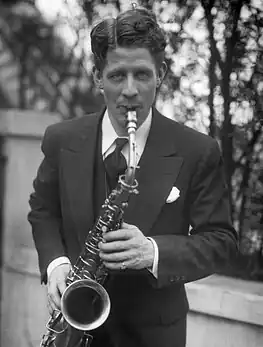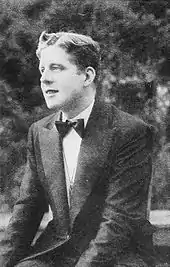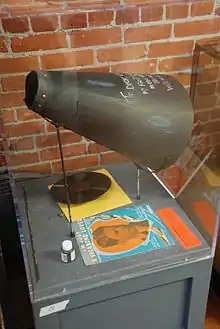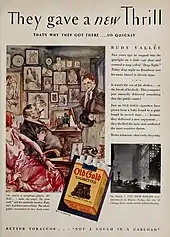Rudy Vallée
Hubert Prior Vallée (July 28, 1901[1] – July 3, 1986),[2] known professionally as Rudy Vallée, was an American singer, musician, songwriter, bandleader, actor, and radio host. He was the first male singer to rise from local radio broadcasts in New York City to national popularity as a "crooner".
Rudy Vallée | |
|---|---|
 Vallée c. late 1920s | |
| Background information | |
| Birth name | Hubert Prior Vallée |
| Born | July 28, 1901 Island Pond, Vermont, U.S. |
| Died | July 3, 1986 (aged 84) Los Angeles, California, U.S. |
| Genres | Traditional pop |
| Occupation(s) |
|
| Instrument(s) | Vocals, saxophone, clarinet |
| Years active | 1924–1984 |
| Labels | Harmony, RCA Victor, Bluebird, Columbia, Hit of the Week, Melotone |
| Website | rudyvallee |
Early life
Hubert Prior Vallée was born in Island Pond, Vermont, United States, on July 28, 1901,[1] the son of Catherine Lynch and Charles Alphonse Vallée. His maternal grandparents were English and Irish, while his paternal grandparents were French-Canadians from Quebec. Vallée grew up in Westbrook, Maine. On March 29, 1917, he enlisted in the US Navy in Portland, Maine to fight in World War I, but authorities discovered he was only 15 years old and had given the false birth date of July 28, 1899. He was discharged at the Naval Training Station in Newport, Rhode Island, on May 17, 1917, after 41 days of active service.
Career
Music

After playing drums in his high school band, Vallée played clarinet and saxophone in bands around New England as a teenager. The popularity of the saxophone and an unexpected reply from his idol Wiedoeft prompted him to perfect his technique. He paid Columbia Records to make four “personal records” which he used for audition purposes with a number of bands. From 1924 to 1925, he played with the Savoy Havana Band at the Savoy Hotel in London, where band members discouraged his attempts to become a vocalist.[3] He returned to the United States, briefly attending the University of Maine. While at the University of Maine, he initiated into Sigma Alpha Epsilon Fraternity on December 5, 1921. He transferred to Yale University in 1924, from which he earned a bachelor’s degree in Philosophy in 1927. As a Yale student he led the football band and was the lead saxophonist in the Yale Collegians with Peter Arno, who became a cartoonist for The New Yorker magazine.[4]
After graduation, he formed Rudy Vallée and the Connecticut Yankees, having named himself after saxophonist Rudy Wiedoeft.[5] With this band (formed in 1928),[6] which included two violins, two saxophones, a piano, a banjo, and drums, he began singing as a member of a trio and as a soloist. He had a thin, wavering tenor voice and seemed more at home singing sweet ballads than jazz songs. But his singing, saxophone playing, and the innovative arrangements he wrote for his band attracted attention from a rapidly increasing number of listeners, especially from young women.[7] In 1928 he started performing on the radio, first at New York station WABC, leading his Yale Collegians Orchestra,[8] and then on WEAF and the NBC Red Network beginning in February 1929.[9]

He became one of the first crooners.[7] Singers needed strong voices to fill theaters in the days before microphones. Crooners had soft voices that were suited to the intimacy of radio; the microphones, in this case, promoted direct access to "a vulnerable and sensuous interior," or in other words, "a conjured intimacy".[10] Vallée was one of the first celebrity radio vocalists.[7] Flappers pursued him wherever he went.[7] His live appearances were usually sold out. Contrary to popular belief, he did not have screaming girls at his appearances. However, his voice still failed to project in venues without microphones and amplification, so he often sang through a megaphone, a device he had used when leading the Yale football band. A caricature of him singing this way was depicted in the Betty Boop cartoon Poor Cinderella (1934).[11] Another caricature is in Crosby, Columbo, and Vallee, which parodies him, Bing Crosby, and Russ Columbo.
In the words of a magazine writer in 1929,
At the microphone he is truly a romantic figure. Faultlessly attired in evening dress, he pours softly into the radio's delicate ear a stream of mellifluous melody. He appears to be coaxing, pleading and at the same time adoring the invisible one to whom his song is attuned.[12]
Vallée had his share of detractors as well as fans when his popularity was at its height. Radio Revue, a radio fan magazine, held a contest in which people wrote letters explaining his success. The winning letter, written by a man who disliked Vallée's music, said, "Rudy Vallee is reaping the harvest of a seed that is seldom sown this day and age: LOVE. The good-looking little son-of-a-gun really and honestly LOVES his audience and his art. He LOVES to please listeners—LOVES it more than he does his name in the big lights, his mug in the papers. He loved all those unseen women as passionately as a voice can love, long before they began to purr and to caress him with two-cent stamps."[13]
Vallée made his first commercial recordings in 1928 for Columbia's low-priced labels Harmony, Velvet Tone, and Diva. He signed with RCA Victor in February 1929 and remained with the company through 1931, leaving after a heated dispute with executives over song selections. He then recorded for the short-lived Hit of the Week label which sold rather poor quality records laminated onto a cardboard base. In August 1932, he signed with Columbia and remained with the label through 1933. Vallée returned to RCA Victor in June 1933; his records were initially issued on Victor's low-priced Bluebird label until November 1933, when he was back on the standard Victor label. He remained with RCA Victor until signing with ARC in 1936. ARC issued his records on the Perfect, Melotone, Conqueror and Romeo labels until 1937, when he again returned to RCA Victor.
With his group the Connecticut Yankees, Vallée's best-known recordings include "The Stein Song" (a.k.a. University of Maine school song) in 1929[14] and "Vieni, Vieni" in the latter 1930s.
His last hit record was a reissue of "As Time Goes By", popularized in the 1942 film Casablanca. Due to the 1942-44 AFM recording ban, RCA Victor reissued the version he had recorded in 1931.[15] During World War II, he enlisted in the United States Coast Guard to help direct the 11th district Coast Guard band as a Chief Petty Officer. He was promoted to Lieutenant and led the 40 piece band to great success. In 1944, he was placed on the inactive list and returned to radio.[16]
According to George P. Oslin, Vallée on July 28, 1933, was the recipient of the first singing telegram. A fan telegraphed birthday greetings, and Oslin had the operator sing "Happy Birthday to You".[17][18][19]
Radio and film

In 1929, Vallée began hosting The Fleischmann's Yeast Hour,[20] a popular radio show with guests such as Fay Wray and Richard Cromwell in dramatic skits. Vallée continued hosting radio shows such as the Royal Gelatin Hour, Vallee Varieties, and The Rudy Vallee Show through the 1930s and 1940s.

When Vallée took his contractual vacations from his national radio show in 1937, he insisted his sponsor hire Louis Armstrong as his substitute.[21] This was the first instance of an African-American hosting a national radio program. Vallée wrote the introduction for Armstrong's 1936 book Swing That Music.
In 1929, Vallée made his first feature film, The Vagabond Lover, for RKO Radio. His first films were made to cash in on his singing popularity. While his initial performances were rather wooden, his acting greatly improved in the late 1930s and 1940s, and by the time he began working with Preston Sturges in the 1940s, he had become a successful comedic supporting player. He appeared opposite Claudette Colbert in Sturges's classic 1942 screwball comedy The Palm Beach Story. Other films in which he appeared include I Remember Mama, Unfaithfully Yours and The Bachelor and the Bobby-Soxer.
In 1955, Vallée was featured in Gentlemen Marry Brunettes, co-starring Jane Russell, Alan Young, and Jeanne Crain. The production was filmed on location in Paris. The film was based on the Anita Loos novel that was a sequel to her acclaimed Gentlemen Prefer Blondes. Gentlemen Marry Brunettes was popular throughout Europe at the time and was released in France as A Paris Pour les Quatre ("Paris for the Four"), and in Belgium as Tevieren Te Parijs.
Vallée performed on Broadway as J.B. Biggley in the 1961 musical How to Succeed in Business Without Really Trying and reprised the role in the 1967 film version.[22] He appeared in the 1960s Batman television series as the villain Lord Marmaduke Ffogg and in 1971 as a vindictive surgeon in the Night Gallery episode "Marmalade Wine".[23]
Vallee-Video
From 1948 to 1952, Vallée owned Vallee-Video, a television production company formed in the early days of national TV broadcasts. The company was incorporated on April 3, 1948.[24] Vallée made 16mm film shorts for television, including These Foolish Things and Under a Campus Moon, in which he appeared himself. Ed Wynn, Pinky Lee, Buddy Lester and Cyril Smith also appeared in Vallee-Video productions.[25] Comedy sequences in the productions featured dubbed-in laughter.[26]
In 1949, Vallee-Video produced one of the first cartoon shows on television, Tele-Comics.[27]
Vallee-Video's breakthrough in 1952 would have been a 15-minute television show based on the Dick Tracy comic strip starring Vallée's friend Ralph Byrd, who played the character in four successful Dick Tracy theatrical serials from 1937 to 1941. Vallée sold the show as a pilot to NBC. Vallée and Byrd also worked on a proposed radio show based on the comic strip Hawkshaw the Detective.[28] However, Byrd died in August 1952, bringing the Dick Tracy production to a halt, and spelling the end for Vallee-Video.[25]
Personal life
Vallée was married four times. He married Jane Greer on December 2, 1943, in Hollywood, but they separated after three months and divorced on July 27, 1944. His fourth and last wife, Eleanor, wrote a memoir called My Vagabond Lover.
Always loyal to Yale University, Vallée never forgot his Maine roots, and maintained an estate at Kezar Lake.[29]
NBC announcer George Ansbro wrote in his memoir that Vallée "had quite a temper and a very foul mouth... almost always the butt of his nastiness was the orchestra... his outbursts were mean-spirited, and he didn't care who overheard".[30] Alton Cook, however, wrote, "Vallée may be fuming at his orchestra, but a Vallée hour rehearsal never quite loses its air of being a gathering of old friends... Rudy is grimly serious about rehearsal. He sometimes has his band spend a quarter-hour going over one short passage that doesn't satisfy him. On those occasions his temper wears thin..."[31]
During his divorce from his first wife, Fay Webb, she alleged that "Vallée is possessed of a violent, vicious, and ungovernable temper, and given to the use of blasphemy and the use of intemperate, vile, and vituperative language, particularly when applied to [her]". She accused him of committing adultery with three women, including actress Alice Faye. Vallée denied the allegations and counter-charged infidelity on her part. The judge found him "not guilty of any misconduct or maltreatment of Webb which detrimentally affected her health, physical or medical condition".[32]
In a heated dispute with producer George White on the set of the 1934 film George White's Scandals, White struck Vallee in the jaw. Dorothy Brooks wrote in 1936, "Other stars on the air have their troubles, their disagreements, and yet you don't read about their ending in black eyes. Only Rudy Vallee seems to figure in endings of this kind." In an interview with Brooks, Vallée claimed he found fighting "savage and stupid" and "the wrong way to try to solve problems, because it never solves them". When asked why he got into fights, he replied, "I just lost my temper. I'll admit I have a too-quick temper."[33]
Vallée died of cancer at his Los Angeles estate, “Silvertip,” on July 3, 1986, while watching the televised centennial ceremonies of the restored Statue of Liberty. His wife Eleanor said that his last words were, "I wish we could be there; you know how I love a party."[34]
Legacy
In 1995, a Golden Palm Star on the Palm Springs, California, Walk of Stars was dedicated to him.[35]
For his work in radio, Vallée was inducted into the Vermont Association of Broadcasters Hall of Fame in 2011.
Discography
Filmography
| Year | Title | Role | Notes |
|---|---|---|---|
| 1929 | Rudy Vallee and His Connecticut Yankees | Himself | Vitaphone Varieties #771;[36] Lost film (soundtrack survives, containing the songs "Deep Night" and "Outside")[37] |
| 1929 | Radio Rhythm | Himself | Short |
| 1929 | The Vagabond Lover | Rudy Bronson | |
| 1929 | Glorifying the American Girl | Himself | |
| 1930 | College Sweethearts | Short | |
| 1931 | Kitty from Kansas City | Himself | Short |
| 1931 | Musical Justice | Judge | Short |
| 1932 | The Musical Doctor | Dr. Vallee | Short |
| 1932 | Rudy Vallee Melodies | Himself | Short |
| 1933 | International House | Himself | |
| 1934 | George White's Scandals | Jimmy Martin | |
| 1934 | Hollywood on Parade # B-9 | Himself | |
| 1935 | Sweet Music | Skip Houston | |
| 1938 | Gold Diggers in Paris | Terry Moore | Alternative title: The Gay Impostors |
| 1939 | Second Fiddle | Roger Maxwell | |
| 1941 | Too Many Blondes | Dick Kerrigan | |
| 1941 | Time Out for Rhythm | Daniel "Danny" Collins | |
| 1942 | The Palm Beach Story | John D. Hackensacker III | |
| 1943 | Happy Go Lucky | Alfred Monroe | |
| 1945 | It's in the Bag | Himself | |
| 1945 | Man Alive | Gordon Tolliver | |
| 1946 | People Are Funny | Ormsby Jamison | |
| 1946 | The Fabulous Suzanne | Hendrick Courtney, Jr. | |
| 1947 | The Sin of Harold Diddlebock | Lynn Sargent | Alternative title: Mad Wednesday |
| 1947 | The Bachelor and the Bobby-Soxer | District Attorney Tommy Chamberlain | Alternative title: Released in the U.K. as Bachelor Knight |
| 1948 | I Remember Mama | Dr. Johnson | |
| 1948 | So This Is New York | Herbert Daley | |
| 1948 | Unfaithfully Yours | August Henshler | |
| 1948 | My Dear Secretary | Charles Harris | |
| 1949 | Mother Is a Freshman | John Heaslip | Alternative title: Mother Knows Best |
| 1949 | The Beautiful Blonde from Bashful Bend | Charles Hingleman | |
| 1949 | Father Was a Fullback | Mr. Roger "Jess" Jessup | |
| 1950 | The Admiral Was a Lady | Peter Pedigrew (Jukebox king) | |
| 1954 | Ricochet Romance | Worthington Higgenmacher | |
| 1955 | Gentlemen Marry Brunettes | Himself | |
| 1957 | The Helen Morgan Story | Himself | Alternative titles: Both Ends of the Candle Why Was I Born? |
| 1967 | How to Succeed in Business Without Really Trying | Jasper B. Biggley | |
| 1968 | Live a Little, Love a Little | Louis Penlow | With Elvis Presley |
| 1968 | The Night They Raided Minsky's | Narrator | Voice |
| 1970 | The Phynx | Himself | |
| 1975 | Slashed Dreams | Proprietor | Alternative title: Sunburst |
| 1976 | Won Ton Ton, the Dog Who Saved Hollywood | Autograph Hound |
| Year | Title | Role | Notes |
|---|---|---|---|
| 1953 | The Ford 50th Anniversary Show | Himself | Song medley and banter with Bing Crosby and Frank Sinatra |
| 1956 | The Johnny Carson Show | Himself | 1 episode |
| 1956–1957 | December Bride | Himself | 2 episodes |
| 1957 | The Lucy-Desi Comedy Hour | Himself | 1 episode |
| 1961 | What's My Line? | Himself | 1 episode |
| 1967 | Batman | Lord Marmaduke Ffogg | 3 episodes |
| 1969 | Petticoat Junction | Herbert A. Smith | Episode: "But I've Never Been In Erie, Pa" |
| 1970 | Here's Lucy | Himself | 1 episode |
| 1971 | Night Gallery | Dr. Francis Deeking | 1 episode |
| 1971–1972 | Alias Smith and Jones | Winford Fletcher | 2 episodes |
| 1976 | Ellery Queen | Alvin Winer | Episode: "The Adventure of the Tyrant of Tin Pan Alley" |
| 1979 | CHiPs | Arthur Forbinger | Episode: "Pressure Point" |
| 1984 | Santa Barbara | Elderly Con | 1 episode (final appearance) |
Gallery
Illustrations
 In the process of being painted by Rolf Armstrong on November 21, 1929
In the process of being painted by Rolf Armstrong on November 21, 1929 Painted by Rolf Armstrong on November 21, 1929
Painted by Rolf Armstrong on November 21, 1929 1929 caricature from Radio Revue
1929 caricature from Radio Revue 1930 caricature from Photoplay
1930 caricature from Photoplay Advertisement for Old Gold Cigarettes with a fabricated biography
Advertisement for Old Gold Cigarettes with a fabricated biography Caricature in the 1932 Merrie Melodies cartoon Crosby, Columbo, and Vallee; note the megaphone and the curl in his hair
Caricature in the 1932 Merrie Melodies cartoon Crosby, Columbo, and Vallee; note the megaphone and the curl in his hair Caricature in the 1934 Betty Boop cartoon Poor Cinderella
Caricature in the 1934 Betty Boop cartoon Poor Cinderella
Magazine covers
 Radio Revue, December 1929
Radio Revue, December 1929 Radio Guide, April 16–22, 1933
Radio Guide, April 16–22, 1933 Radio Stars, May 1933
Radio Stars, May 1933 Radio Mirror, December 1934
Radio Mirror, December 1934 Radio Stars, May 1936
Radio Stars, May 1936
Videos
- Kitty from Kansas City (1931)
See also
- Vallee Family House, a house listed on the National Register of Historic Places in Westbrook, Maine
References
- Colin Larkin, ed. (1992). The Guinness Encyclopedia of Popular Music (First ed.). Guinness Publishing. p. 2571. ISBN 0-85112-939-0.
- "» Died On This Date (July 3, 1986) Rudy Vallee / Singer & Bandleader". Themusicsover.com. July 3, 2010. Retrieved October 16, 2021.
- Rust, Brian, "The Savoy Havana at the Savoy Hotel, London", sleeve notes to disc 2 of World Record Club LP set SH165/6, issued 1971
- "Cartoonist Peter Arno of the New Yorker Dies". The Milwaukee Journal. February 23, 1968. Part 1, p. 20.
- "How Rudy Wiedoeft's Saxophobia Launched the Saxual Revolution" (PDF). Garfield.library.upenn.edu. Retrieved September 29, 2019.
- Walker p. 167
- Whitcomb, Ian. "The Coming of the Crooners". Sam Houston University. Retrieved June 24, 2010.
- "Tonight's Features from Nearby Stations," Bridgewater NJ Courier-News, March 3, 1928, p. 4,
- "Tomorrow's Radio Programs," St. Cloud MN Times, February 26, 1929, p. 5.
- Brothers, Thomas (2014). Louis Armstrong: Master of Modernism. New York, NY: W.W. Norton & Company. p. 400. ISBN 978-0-393-06582-4.
- "Betty Boop: Poor Cinderella". Archive.org. September 29, 1934.
- "What is the Secret of Rudy Vallee's Success?". Radio Revue. New York. December 1929. Retrieved November 7, 2015.
- Hansen, Martin (January 1930). "Mere Man Wins First Prize in Rudy Vallee Contest". Radio Revue. New York. Retrieved November 7, 2015.
- "The Maine Stein Song by Rudy Vallée - Songfacts". Songfacts.com.
- Gilliland, John (1994). Pop Chronicles the 40s: The Lively Story of Pop Music in the 40s (audiobook). ISBN 978-1-55935-147-8. OCLC 31611854. Tape 1, side A.
- USCG: Frequently Asked Questions. Uscg.mil. Retrieved on 2012-01-30.
- "The Singing Telegram At 50". The New York Times. 1983. Retrieved September 13, 2018.
- Liz Sadler. "Special delivery: The singing telegram endures". Columbia News Service. Columbia School of Journalism. Archived from the original on November 8, 2006. Retrieved September 13, 2018.
- "The First Singing Telegram". Sound Beat. Syracuse University Libraries. Retrieved September 13, 2018.
- Walker p.169
- Features Archives. onhifi.com (March 1, 2002). Retrieved on 2012-01-30.
- Colin Larkin, ed. (1997). The Virgin Encyclopedia of Popular Music (Concise ed.). Virgin Books. p. 1208. ISBN 1-85227-745-9.
- Skelton, Scott; Benson, Jim (1998). Rod Serling's Night Gallery: An After-hours Tour. Syracuse University Press. pp. 159–. ISBN 978-0-8156-0535-5. Retrieved December 21, 2018.
- "Vallee-Video". OpenCorporates. Retrieved March 7, 2020.
- Pitts, Michael; Hoffman, Frank (2001). The Rise of the Crooners: Gene Austin, Russ Columbo, Bing Crosby, Nick Lucas, Johnny Marvin, and Rudy Vallee. Scarecrow Press. p. 204. ISBN 978-0810840812. Retrieved March 7, 2020.
- "Vallee Sees Separate Coast TV Depts., Sub-Divided Studios as Aids to Biz". Variety. February 2, 1949. p. 26. Retrieved January 17, 2023.
- Woolery, George W. (1983). Children's Television: The First Thirty-Five Years, 1946-1981. The Scarecrow Press. pp. 285–286. ISBN 0-8108-1557-5. Retrieved March 5, 2020.
- "Vallee-NBC in Deal on 'Tracy' Telefilms". The Billboard. Vol. 61, no. 22. May 28, 1949. p. 12. Retrieved March 7, 2020.
- C. Stewart Doty, "Rudy Vallee: Franco-American and Man from Maine", Maine Historical Society Quarterly 1993 33(1): 2–19
- Ansbro, George (February 1, 2000). I Have a Lady in the Balcony: Memoirs of a Broadcaster in Radio and Television. McFarland. pp. 89–. ISBN 978-0-7864-4318-5. Retrieved December 21, 2018.
- Cook, Alton (April 18, 1937). "Rudy Acts Like Real Tough Guy". The Pittsburgh Press. Retrieved January 15, 2016.
- Fay Webb Vallee v. Hubert Prior Vallee. p. 56. Retrieved December 21, 2018.
- Brooks, Dorothy (August 1936). "Why I Always Have to Fight". Radio Mirror. Broadway, New York. Retrieved December 31, 2015.
- Obituary, Los Angeles Times, July 4, 1986.
- "The Brightest Stars" (PDF). Palmspringswalkofstars.com. Archived from the original on October 13, 2012.
- Picking, Patrick (2007). "Vitaphone Thrills the World During Event-Filled Year". The Vitaphone Project. Patrick J. Picking. Retrieved February 14, 2016.
- "Rudy Vallee & His Connecticut Yankees Vitaphone". SoundCloud. Vitaphone. 2012. Retrieved February 14, 2016.
Bibliography
- Walker, Leo. (1976) "The Wonderful Era of the Great Dance Bands"
Further reading
- McCracken, Allison (2001). "Real Men Don't Sing Ballads (Section:The Rise and Fall of Rudy Vallée)". In Wojcik, Pamela Robertson; Knight, Arthur (eds.). Soundtrack Available: Essays on Film and Popular Music. Duke University Press. pp. 113–. ISBN 0-8223-2797-X. Retrieved December 21, 2016.
External links
- Official site
- Rudy Vallee Collection Archived March 3, 2016, at the Wayback Machine at the American Radio Archive the Thousand Oaks Library
- Virtual History
- A collection of rare aluminum transcription discs of some of Vallée's radio broadcasts is housed in the Great American Songbook Foundation archives
- Grave
- Rudy Vallée at IMDb
- Rudy Vallée at the Internet Broadway Database
- Rudy Vallée at AllMusic
- Rudy Vallée recordings at the Discography of American Historical Recordings.
Media
- The Royal Desserts Hour with Rudy Vallée (May 5, 1938) (one hour in)
- Recordings on Standard Labels at the Internet Archive
- Recordings on Discount Labels at the Internet Archive
- More recordings (including unreleased personal recordings) at the Internet Archive